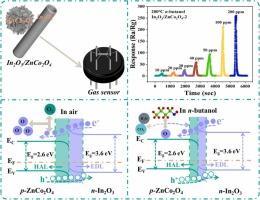MOFs-derived In2O3 hollow microtubes/ZnCo2O4 microflowers for fast and sensitive detection of n-butanol
IF 8
1区 化学
Q1 CHEMISTRY, ANALYTICAL
引用次数: 0
Abstract
Metal-organic frameworks (MOFs)-derived metal oxides have a high specific surface area and porous structure, making them promising for gas sensing applications. In this paper, MOFs-derived In2O3/ZnCo2O4 composites were synthesized using a two-step solvothermal method. Through a series of characterization strategies, it is revealed that the morphology of the In2O3/ZnCo2O4 composites consists of hollow microtubes and microflowers. The gas sensing performance of In2O3/ZnCo2O4 composites was significantly enhanced compared to pure In2O3. Among them, the In2O3/ZnCo2O4-2 sensor exhibited superior performance towards 100 ppm n-butanol gas, with a lower operating temperature of 200℃, a higher response value of 208.7, a lower detection limit of 4.2 ppb, shorter response/recovery times of 152 s/223 s, higher selectivity, and better repeatability. Furthermore, the improved gas response can be attributed to the utilization of MOFs as self-sacrificial templates, the high specific surface area of the sensing materials, and the formation of p-n heterojunctions. This study provides a valuable reference for synthesizing n-butanol sensing materials with a high specific surface area, strong response, and excellent selectivity.

基于 MOFs 的 In2O3 中空微管/ZnCo2O4 微流体用于快速灵敏地检测正丁醇
金属有机框架(MOFs)衍生的金属氧化物具有高比表面积和多孔结构,因此在气体传感应用中大有可为。本文采用两步溶热法合成了由 MOFs 衍生的 In2O3/ZnCo2O4 复合材料。通过一系列表征策略,发现 In2O3/ZnCo2O4 复合材料的形貌由空心微管和微流组成。与纯 In2O3 相比,In2O3/ZnCo2O4 复合材料的气体传感性能明显提高。其中,In2O3/ZnCo2O4-2 传感器对 100 ppm 正丁醇气体具有更优越的性能,工作温度更低,为 200℃,响应值更高,为 208.7,检测限更低,为 4.2 ppb,响应/恢复时间更短,为 152 秒/223 秒,选择性更高,重复性更好。此外,气体响应的改善还归功于利用 MOFs 作为自牺牲模板、传感材料的高比表面积以及 p-n 异质结的形成。这项研究为合成具有高比表面积、强响应和优异选择性的正丁醇传感材料提供了有价值的参考。
本文章由计算机程序翻译,如有差异,请以英文原文为准。
求助全文
约1分钟内获得全文
求助全文
来源期刊

Sensors and Actuators B: Chemical
工程技术-电化学
CiteScore
14.60
自引率
11.90%
发文量
1776
审稿时长
3.2 months
期刊介绍:
Sensors & Actuators, B: Chemical is an international journal focused on the research and development of chemical transducers. It covers chemical sensors and biosensors, chemical actuators, and analytical microsystems. The journal is interdisciplinary, aiming to publish original works showcasing substantial advancements beyond the current state of the art in these fields, with practical applicability to solving meaningful analytical problems. Review articles are accepted by invitation from an Editor of the journal.
 求助内容:
求助内容: 应助结果提醒方式:
应助结果提醒方式:


